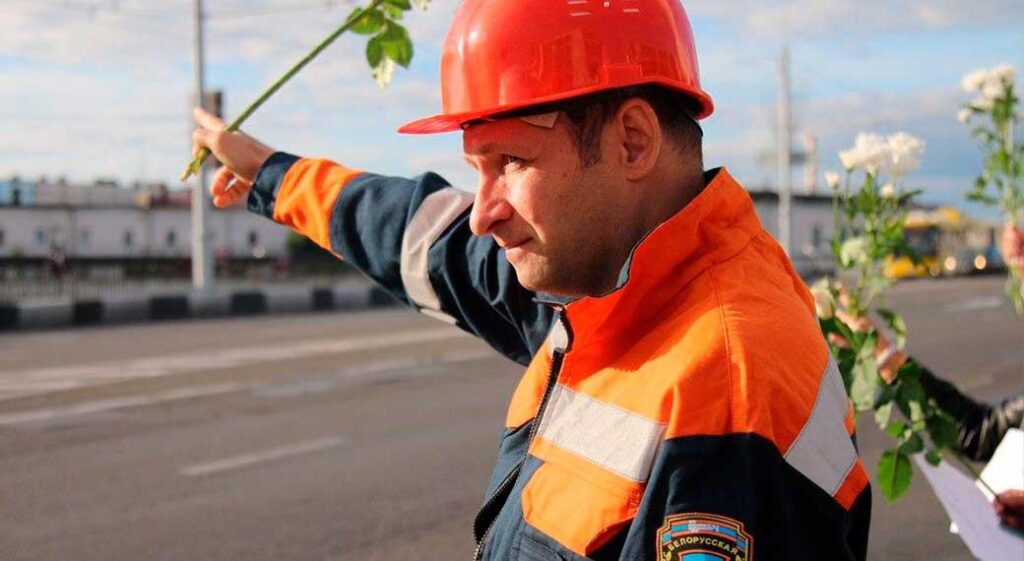Political protests in Belarus began immediately after the closing of polling stations on the night of August 9, 2020. The initial spontaneous street riots grew in scale owing to the asymmetrically brutal reaction of the authorities. In this piece, Kseniya Zaika offers an account of worker participation in the protest movement and a reflection on the reasons for the failure of the national strike.

I would like to start with the fact that, with a certain degree of conditionality, the Belarusian protest movement can be characterised as a modern urban bourgeois protest, since after the first week, after the revolutionary momentum vanished, the protest was mainly supported by representatives of such social and socio-demographic strata of the population as entrepreneurs, IT specialists, their wives, representatives of the creative class. With the beginning of the academic year, some students joined the protests. Nevertheless, as early as August 17, “more than 10 large enterprises in the country went on strike. Workers demanded that the government stops force against protesters, that it releases all detainees and reviews the results of the elections. No economic demands had been articulated”.[1] I want to draw attention to the last point. Without putting forward economic demands, the protesting labor collectives were considered by the protest leaders as a kind of auxiliary force, not a leading one. On the one hand, it was the first strategic mistake of the opposition in the country where more than a million people are employed in industry and related organizations. On the other hand, the nationalist-bourgeois protest movement does not necessarily express the interests of the working class—something the workers realized after reading S. Tikhonovskaya’s reform program, which involves large-scale neoliberal transformations.
On October 26, 2020, a nationwide strike was to begin in Belarus, which was called for by the protest leader Svetlana Tikhanovskaya as A. Lukashenko ignored the provisions of the People’s Ultimatum announced by the opposition leaders earlier. The People’s Ultimatum aggregated the diverse political demands into three clear steps: the release of all political prisoners, the resignation of A. Lukashenko, and the organization of preterm presidential elections. However, only some small service sector businesses responded to the call. Strategic industrial transport and infrastructure enterprises continued to operate at full capacity. There are several reasons for the failure of this national strike.
Some of these lie within the the realm of ideology. The nationalist platform, typical for the “small” Eastern European countries, within which the protest leader S. Tikhanovskaya and her team have been building the program of political and economic changes, in principle does not imply large industrial projects as the basis for national state development. Their unsubstantiated calls for a nation-wide strike were doomed to failure due to their misunderstanding of strategies of communicating with labor collectives in the crisis hit environment.
The industrial heavy-hitters stayed unresponsive to the calls of the opposition leaders based abroad, with the exception of some one-man protests or sporadic incidents. According to Russian Business Channel, “The strike call was supported by the (individual) workers of the Minsk plant “Integral”, which produces microchips; employees of the household appliances factory “Atlant” and multi-unit agricultural enterprise “Dzerzhinsky”. …. About 100 employees of the chemical enterprise “Grodno Azot” were gathering at the entrance on the morning of October 26th. They refused to take over the working shifts.”[2]
Being idealists and political romantics, the protest leaders suggested that the regime of A. Lukashenko (hereinafter – the regime) is financially supported by state-owned enterprises. Hence, mobilising the workers to take part in the strike and shutting down the factories was designed as an instrument to undermine the economic foundation of Lukashenko’s regime. In reality, it is the regime that subsidizes many unprofitable state-owned enterprises by borrowing money on the foreign markets, thus supporting the phenomenon that I call socio-economic infrastructure based on socialist inertia. This occurs when a strategic enterprise sponsors a set of public institutions like schools, clinics, rehabilitation centres, kindergartens, schemes of the preferential mortgages for their employees. These are “unjustifiably excessive” expenses as seen in the market economy.
With the exception of such companies as Belneftekhim consortium (oil processing) and Belaruskali (one of the world’s largest manufacturers of potash fertilizers), Belarusian state-owned enterprises for the most part are uncompetitive precisely because they are “burdened” by the government with such social functions. In other words, in Belarusian case, the lack of market competitiveness of enterprises can be explained by the fact that long-run and direct state subsidies to industrial enterprises in Belarus should be analysed in the view of their social significance seeing that they maintain the system of public and social security and social prestige of blue-collar jobs. Accordingly, the possible dismissal of even a third of employees in the event of their active protest activities might actually bring a temporary relief to the regime in terms of its social commitments, however ruthless this might sound. Given the policy of zero tolerance that A. Lukashenko has been demonstrating in the last 4 months, even a mass politically charged layoff and a possible exodus of population will only consolidate his regime in the short term.[3]
More importantly, strikes cannot be merely called without any preliminary, practical work on part of the protest leaders. In order to achieve a political effect as a result of the nation-wide strike, the workers of the industrial and infrastructural enterprises should totally refuse to fulfill their labor obligations for a fairly short period of time (one to two weeks), thus taking on a great personal risk. No one should work with the exception of the rescue services. It is of paramount importance that transportation providers’ enterprises in particular go on all out strike. However, if the protest leaders have not previously shown any inclination to work ideologically with workers, a nationwide strike at enterprises, many of which are subsidised by the government, is doomed to fail. In other words, the protest leaders have so far fantasized the political strike that the workers were assumed to support. In reality, a general strike is only possible if based on the preliminary meticulous mobilizing efforts undertaken by grassroots oppositional activists and on a realistic economic platform that speaks to the strikers. Otherwise—and we can observe this phenomenon in Belarus—protest activity at enterprises has been transformed into sabotage.
Without such labor by the protest leaders, workers will go on strike only for economic reasons, in case the terms of the contract are not fulfilled, working conditions are violated, and wages are not paid, that is to say, based on the conditions of a galloping socio-economic crisis. According to Snezana Rogach, Associate Professor at the Department of Political Science at Belarussian State Technical University, the government is currently reorienting scarce resources to fund its security apparatus. This excessive financing of the law-enforcement agencies might mean a catastrophic and irreversible increase in the socio-economic crisis, which can in turn help the crystallization of a total revolutionary situation.
Such a possibility cannot be dismissed providing the economic situation in the country is going to deteriorate dramatically. However, at the moment, the protesting community has transformed into a mainly youthful kind of subculture, whose slogans are ambiguous and who are actively engaging nationalist (not national) symbols. The latter, apparently, do not resonate with the political imaginary of the majority of Belarussians.

Kseniya Zaika is is originally from Minsk, Belarus, where she got her BA in History at the Belarussian State Pedagogical University. In Moscow, Kseniya first received an MA in Political Science at Moscow School of Social and Economic Sciences and then a PhD in the same field at the Institute of Philosophy, Russian Academy of Sciences. Her areas of specialization are Canadian political history, nation-state building and diaspora studies. She is currently teaching at University of Winnipeg, Manitoba, Canada.
[1] «Забастовки в Белоруссии: Какие предприятия против Лукашенко». DW. https://www.dw.com/ru/zabastovki-v-belarusi-kakie-predprijatija-protiv-lukashenko/a-54599090 (17.08.2020).
[2] «Забастовки на предприятиях в Белоруссии. Главное». РБК. https://www.rbc.ru/politics/26/10/2020/5f3a229a9a794720e12059af (26.10.2020)
[3] This point is not relevant any longer as Belarussian government locked down its borders as of December 20, 2020, with the exception of plane travel.

